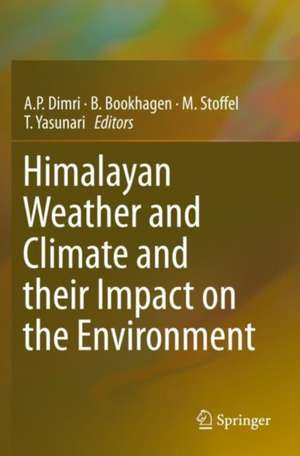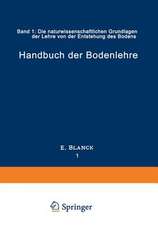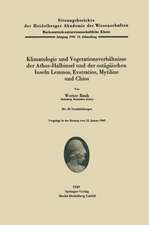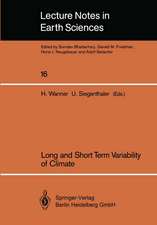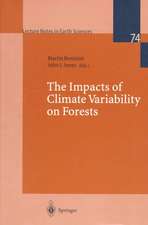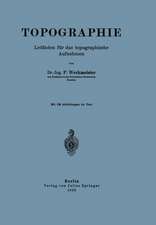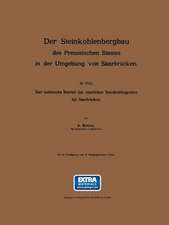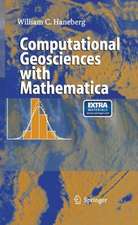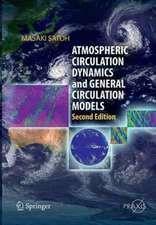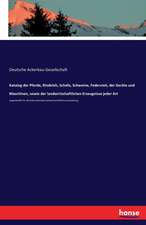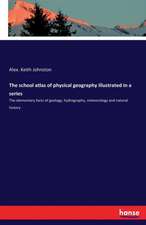Himalayan Weather and Climate and their Impact on the Environment
Editat de A.P. Dimri, B. Bookhagen, M. Stoffel, T. Yasunarien Limba Engleză Paperback – 20 noi 2020
| Toate formatele și edițiile | Preț | Express |
|---|---|---|
| Paperback (1) | 922.65 lei 38-44 zile | |
| Springer International Publishing – 20 noi 2020 | 922.65 lei 38-44 zile | |
| Hardback (1) | 938.25 lei 38-44 zile | |
| Springer International Publishing – 20 noi 2019 | 938.25 lei 38-44 zile |
Preț: 922.65 lei
Preț vechi: 1214.01 lei
-24% Nou
Puncte Express: 1384
Preț estimativ în valută:
176.57€ • 183.66$ • 145.77£
176.57€ • 183.66$ • 145.77£
Carte tipărită la comandă
Livrare economică 09-15 aprilie
Preluare comenzi: 021 569.72.76
Specificații
ISBN-13: 9783030296865
ISBN-10: 3030296865
Pagini: 577
Ilustrații: XIV, 577 p. 210 illus., 185 illus. in color.
Dimensiuni: 155 x 235 mm
Greutate: 1.05 kg
Ediția:1st ed. 2020
Editura: Springer International Publishing
Colecția Springer
Locul publicării:Cham, Switzerland
ISBN-10: 3030296865
Pagini: 577
Ilustrații: XIV, 577 p. 210 illus., 185 illus. in color.
Dimensiuni: 155 x 235 mm
Greutate: 1.05 kg
Ediția:1st ed. 2020
Editura: Springer International Publishing
Colecția Springer
Locul publicării:Cham, Switzerland
Cuprins
Part-I: Weather and Climate
Chapter -1: Manifestations and contours of extreme high altitude climate change in the upper Karakoram Himalaya (Lead: Dr. M. R. Bhutiyani)
Chapter 2: Changes in the large-scale circulations over north-west India (Lead: Dr. Ramesh Yadav)
Chapter 3: Himalayan uplift and the Human evolution (Lead: Prof. T. Yasunari)
Chapter 4: Projected Climate Change in the Himalayas during the 21st Century (Lead: Prof. I. Rangwala)
Chapter 5: Dynamic Downscaling of Himalayan Climate (Lead: Dr. Sarat Kar)
Chapter 6: Representation of the Himalayas in Weather and Climate models (Lead: Prof. Someshwar Das)
Chapter 7: The Himalayan System: A Perspective (Lead: Prof. Shailesh Nayak)
Chapter 8: Changes in pan evaporation and causative parameters: A case study from eastern Himalayan region (Lead: Dr. Deepak Jhajaria)
Chapter 9: Land atmosphere interaction over the Himalayan region (Lead: Prof. Dev Niyogi)
Chapter 10: Impact of Nino phases on the summer monsoon ISO modes of northwestern and eastern Himalaya (Lead: Dr. Sandeepan Mukherjee)
Chapter 11: Remotely-sensed rain and snowfall in the Himalaya (Lead Prof. Bodo Bookhagen)
Part-II: Paleoclimate
Chapter 12: Multi-proxy records of climate variations for the Himalaya (Lead: Dr. Masaki Sano)
Chapter 13: Erosion in the Himalaya and its Coupling with Climate and Tectonics (Lead: Prof. Sunil Singh)
Chapter 14: Tracking back the climatic variability and role of Indian winter monsoon in the central and western Himalaya: using proxy data (Lead: Dr. J. Sanwal)
Chapter 15: Spatio-temporal variability of Stream flow in the Himalayan Region (Lead: Dr. Amalav Bhattacharya)
Chapter 16: Quaternary glaciation of the Himalaya (Lead: Prof. L. Owen)
Chapter 17: Geomorphological changes during Quaternary Period vis a vis role of climate and tectonics in Ladakh sector of Trans-Himalaya (Lead: Dr. Anupam Sharam)
Chapter 18: Climate and Source Identification of Organic Matter Using C/N Ratio in Freshwater Lakes of Kashmir Himalaya (Lead: Prof. H. Achyuthan)
Chapter 19: Deciphering Climate Variability over Western Himalaya Using Instrumental and Tree-ring Records (Lead: Dr. H. Borgaonkar)
Part-III: Snow, glaciers and hydrology
Chapter 20: Hydrology of cold-arid system cryosphere (Lead: Dr. R. Thayyen) Chapter 21: Glacio-hydrological model based on degree-day factor useful for the Himalayan River basins (Lead: Prof. R. B. Kayastha)
Chapter 22: Observed changes in north west and central Himalayan cryosphere due to climate change (Lead: Dr. H. S. Negi)
Chapter 23: Impacts of climate change on Himalayan glaciers: processes, predictions and uncertainties (Lead: Dr. Richard Betts)
Chapter 24: Hydrology of Himalayas (Lead: Dr. S. K. Jain)
Chapter 25: Permafrost and seasonally frozen soil in the Himalaya (Lead: Dr. Stephan Gruber)
Chapter 26: Sensitivity of glaciers in part of the Suru basin, western Himalaya to ongoing climatic perturbations (Lead: Dr. A. Shukla)
Chapter 27: floods and changes in their activity in the Indian Himalayan Region (Lead: Prof. Markus Stoffel)
Part-IV: Ecology/Forestry
Chapter 28: Solving life on the move: developing a disperser functional classification for sub-Himalayan tropical forests (Lead: Dr. Soumya Prasad)
Chapter 29: Climate Change Trends and Ecosystem Resilience in the Hindu Kush Himalayas (Lead: Dr. Eklavya Sharma)
Chapter 30: Social science perspectives on vulnerability to seasonal to interannual variability in the Himalayan region (Lead: Dr. M. E. Daly)
Chapter 31: Issues of sustainability in a rapid warming Himalayas (Lead: Prof. S. P. Singh)
Chapter 32: Challenges of Urban Growth Himalaya with Reference to Climate Change and Disaster Risk Mitigation (Lead: Prof. P. C. Tiwari)
Chapter -1: Manifestations and contours of extreme high altitude climate change in the upper Karakoram Himalaya (Lead: Dr. M. R. Bhutiyani)
Chapter 2: Changes in the large-scale circulations over north-west India (Lead: Dr. Ramesh Yadav)
Chapter 3: Himalayan uplift and the Human evolution (Lead: Prof. T. Yasunari)
Chapter 4: Projected Climate Change in the Himalayas during the 21st Century (Lead: Prof. I. Rangwala)
Chapter 5: Dynamic Downscaling of Himalayan Climate (Lead: Dr. Sarat Kar)
Chapter 6: Representation of the Himalayas in Weather and Climate models (Lead: Prof. Someshwar Das)
Chapter 7: The Himalayan System: A Perspective (Lead: Prof. Shailesh Nayak)
Chapter 8: Changes in pan evaporation and causative parameters: A case study from eastern Himalayan region (Lead: Dr. Deepak Jhajaria)
Chapter 9: Land atmosphere interaction over the Himalayan region (Lead: Prof. Dev Niyogi)
Chapter 10: Impact of Nino phases on the summer monsoon ISO modes of northwestern and eastern Himalaya (Lead: Dr. Sandeepan Mukherjee)
Chapter 11: Remotely-sensed rain and snowfall in the Himalaya (Lead Prof. Bodo Bookhagen)
Part-II: Paleoclimate
Chapter 12: Multi-proxy records of climate variations for the Himalaya (Lead: Dr. Masaki Sano)
Chapter 13: Erosion in the Himalaya and its Coupling with Climate and Tectonics (Lead: Prof. Sunil Singh)
Chapter 14: Tracking back the climatic variability and role of Indian winter monsoon in the central and western Himalaya: using proxy data (Lead: Dr. J. Sanwal)
Chapter 15: Spatio-temporal variability of Stream flow in the Himalayan Region (Lead: Dr. Amalav Bhattacharya)
Chapter 16: Quaternary glaciation of the Himalaya (Lead: Prof. L. Owen)
Chapter 17: Geomorphological changes during Quaternary Period vis a vis role of climate and tectonics in Ladakh sector of Trans-Himalaya (Lead: Dr. Anupam Sharam)
Chapter 18: Climate and Source Identification of Organic Matter Using C/N Ratio in Freshwater Lakes of Kashmir Himalaya (Lead: Prof. H. Achyuthan)
Chapter 19: Deciphering Climate Variability over Western Himalaya Using Instrumental and Tree-ring Records (Lead: Dr. H. Borgaonkar)
Part-III: Snow, glaciers and hydrology
Chapter 20: Hydrology of cold-arid system cryosphere (Lead: Dr. R. Thayyen) Chapter 21: Glacio-hydrological model based on degree-day factor useful for the Himalayan River basins (Lead: Prof. R. B. Kayastha)
Chapter 22: Observed changes in north west and central Himalayan cryosphere due to climate change (Lead: Dr. H. S. Negi)
Chapter 23: Impacts of climate change on Himalayan glaciers: processes, predictions and uncertainties (Lead: Dr. Richard Betts)
Chapter 24: Hydrology of Himalayas (Lead: Dr. S. K. Jain)
Chapter 25: Permafrost and seasonally frozen soil in the Himalaya (Lead: Dr. Stephan Gruber)
Chapter 26: Sensitivity of glaciers in part of the Suru basin, western Himalaya to ongoing climatic perturbations (Lead: Dr. A. Shukla)
Chapter 27: floods and changes in their activity in the Indian Himalayan Region (Lead: Prof. Markus Stoffel)
Part-IV: Ecology/Forestry
Chapter 28: Solving life on the move: developing a disperser functional classification for sub-Himalayan tropical forests (Lead: Dr. Soumya Prasad)
Chapter 29: Climate Change Trends and Ecosystem Resilience in the Hindu Kush Himalayas (Lead: Dr. Eklavya Sharma)
Chapter 30: Social science perspectives on vulnerability to seasonal to interannual variability in the Himalayan region (Lead: Dr. M. E. Daly)
Chapter 31: Issues of sustainability in a rapid warming Himalayas (Lead: Prof. S. P. Singh)
Chapter 32: Challenges of Urban Growth Himalaya with Reference to Climate Change and Disaster Risk Mitigation (Lead: Prof. P. C. Tiwari)
Notă biografică
A. P. Dimri is Professor at the School of Environmental Sciences, Jawaharlal Nehru University, New Delhi, India. His research interests include Indian weather and climate using observations and modeling tools, regional climate dynamics and its variability, statistical and dynamical downscaling of numerical model outputs, extreme events and their physical understanding, particularly over the Himalayan massif. He has significantly contributed to the important dimensions of Western Disturbances and Indian Winter Monsoon by explaining the precipitation mechanisms occurring during winter. Emphasis of his studies is on winter snowfall leading to glacier replenishment which provides an insight for the recharging of the snow-fed rivers and overall ecology of the region. Dr. Dimri has been a member of important committees and published works.
B. Bookhagen is Associate Professor at the Department of Geography, UC Santa Barbara, USA. His research interests include the understanding of Quaternary climate change, geomorphic processes, landscape evolution, and tectonic processes through integrated studies involving cosmogenic radionuclide dating (He, Ne, Be, Al, Cl), recent and past climatic records, remote sensing, numerical modeling, and field observations. Spatial scales range from hillslopes (100 km2) to entire mountain ranges (~103 km). For smaller scale analysis, Dr. Bookhagen uses a terrestrial laser scanner (Riegl) to create high resolution, cm-scale digital elevation models for erosion-process deciphering. He has a number of publications to his credit.
Markus Stoffel is Full Professor at the Institute for Environmental Sciences (ISE), and is Director of the Swiss Tree-Ring Lab at the Department F.-A. Forel for the Aquatic Sciences and the Department of Earth Sciences of the University of Geneva. His research interests are in hydrogeomorphic and earth-surface processes, climate change impacts, and dendroecology. He has authored more than 200 peer-reviewed papers on geomorphic, hydrologic, cryospheric, and geologic processes in mountain and hillslope environments, with a focus on time series of frequency and magnitude and process dynamics, as well as dendroecology and wood anatomy of trees and shrubs, and integrated water resources management. Dr. Stoffel has collaborated with important co-editors-in-chief of the Journal Geomorphology (Elsevier) and guest editors of scientific journals. He has also co-edited both books and an encyclopedia.
T. Yasunari is Director General of the Research Institute of Humanity and Nature in Kyoto, Japan. He has held many positions in international scientific programs and contributed to the development of key theories on the Indian summer monsoon. He has many publications to his credit.
B. Bookhagen is Associate Professor at the Department of Geography, UC Santa Barbara, USA. His research interests include the understanding of Quaternary climate change, geomorphic processes, landscape evolution, and tectonic processes through integrated studies involving cosmogenic radionuclide dating (He, Ne, Be, Al, Cl), recent and past climatic records, remote sensing, numerical modeling, and field observations. Spatial scales range from hillslopes (100 km2) to entire mountain ranges (~103 km). For smaller scale analysis, Dr. Bookhagen uses a terrestrial laser scanner (Riegl) to create high resolution, cm-scale digital elevation models for erosion-process deciphering. He has a number of publications to his credit.
Markus Stoffel is Full Professor at the Institute for Environmental Sciences (ISE), and is Director of the Swiss Tree-Ring Lab at the Department F.-A. Forel for the Aquatic Sciences and the Department of Earth Sciences of the University of Geneva. His research interests are in hydrogeomorphic and earth-surface processes, climate change impacts, and dendroecology. He has authored more than 200 peer-reviewed papers on geomorphic, hydrologic, cryospheric, and geologic processes in mountain and hillslope environments, with a focus on time series of frequency and magnitude and process dynamics, as well as dendroecology and wood anatomy of trees and shrubs, and integrated water resources management. Dr. Stoffel has collaborated with important co-editors-in-chief of the Journal Geomorphology (Elsevier) and guest editors of scientific journals. He has also co-edited both books and an encyclopedia.
T. Yasunari is Director General of the Research Institute of Humanity and Nature in Kyoto, Japan. He has held many positions in international scientific programs and contributed to the development of key theories on the Indian summer monsoon. He has many publications to his credit.
Textul de pe ultima copertă
This book proposes a unique and comprehensive integrated synthesis of the current understanding of the science of Himalayan dynamics and its manifestations on physical systems and ecosystems at different spatial and temporal scales. In particular, this work covers relevant aspects of weather and climate, paleoclimate, snow, glacier and hydrology, ecology/forestry among other topics associated with the Himalayas. It highlights the role of the Himalayas in defining local to regional to global scale impact on weather and climate. It includes Himalayan impact on defining physical basis of changing glacier systems, permafrost melting/thawing, climate variability, and hydrological balances. As a result, this volume represents an important synthesized overview both for environmental and earth science researchers, and for policy makers and stakeholders interested in the physical and dynamical processes associated with the Himalayan massif.
Caracteristici
Provides a comprehensive and integrated contribution to the study of the Himalayan massif
Exposes various unique scientific dimensions of the Indian Himalayan region
Fills the gaps in the field of global weather and climate through research on the Himalayas
Exposes various unique scientific dimensions of the Indian Himalayan region
Fills the gaps in the field of global weather and climate through research on the Himalayas
